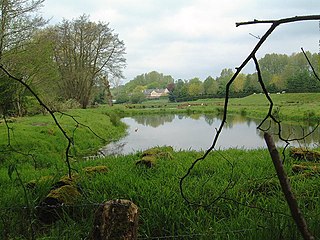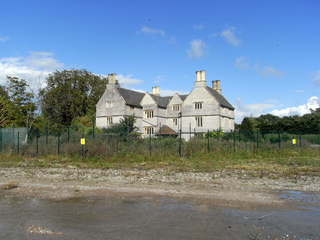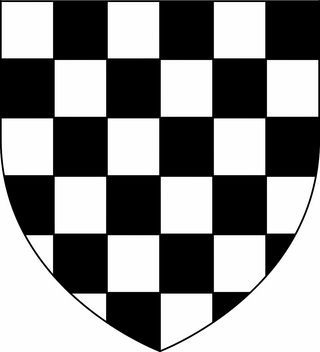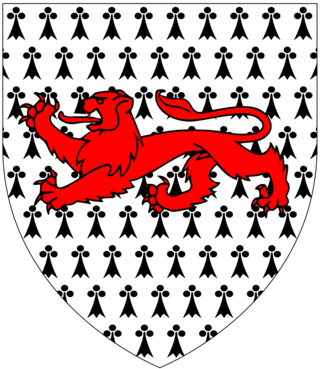

Combe is a historic estate in Somerset, England, situated between the town of Dulverton and the village of Brushford.


Combe is a historic estate in Somerset, England, situated between the town of Dulverton and the village of Brushford.
Until the Dissolution of the Monasteries under King Henry VIII, the estate was one of the possessions of Taunton Priory, which also held the manor of Dulverton. [2]
In the medieval period the Combe estate was probably held by the Combe family, although in 1254 the lord of Dulverton, Richard de Turberville, held land there. Alfred of Combe, the Bailiff of Dulverton in 1225, may have come from the estate – doubt arises because Combe, meaning steep-sided valley, is a common name in west Somerset. [3] In 1425 John Combe was a free tenant of Taunton Priory, and Joan Combe, who has been assumed to be an heiress to the estate, married Edward Sydenham at some time before 1506, [3] to whose Sydenham descendants Combe was home until 1874. [4]


It was the seat of a junior branch of the de Sydenham (later Sydenham) family, [5] [6] which took its surname from the manor of Sydenham, near Bridgwater in Somerset. The family split into many prominent branches, the senior branch seated at Sydenham and Kittisford died out in the male line in the 15th century when Sydenham passed via the heiress to the Cave family, then to the Percival family, later Earl of Egmont. The next senior line was seated in the early 15th century at Combe Sydenham in the parish of Stogumber, Somerset, of which family was Simon Sydenham (died 1438), Bishop of Chichester, and which later inherited the Somerset manors of Orchard Sydenham (later called Orchard Wyndham) and Brympton d'Evercy, which latter remained the seat of the Sydenham baronets, which title was created in 1641. [7] In 1871 Rev. Charles St. Barbe Sydenham (1823–1904), whose son was born at Combe in 1861, was declared bankrupt, which may have necessitated the sale of Combe. The descent of Combe in the Sydenham family was as follows:
Edward Sydenham, who at some time before 1506 married Joan de Combe, daughter and heiress of Walter de Combe of Combe. [3] He was descended from John de Sydenham (eldest son of Roger de Sydenham (fl.1331) of Sydenham and Kittisford) who married Mary de Pixton, daughter and heiress of John de Pixton (alias Peekstone) of Pixton in the parish of Dulverton, situated across the River Barle from Combe. [8] In 1506, together with John Doune of Exebridge, he obtained a lease of the manors of Brushford, Dulverton, Milverton, Halse and Stoke Pero and the advowson of Brushford with the next vacancy for £16 10s rent, from William Byrte, son and heir of William Byrte of Brushford. [9]
John Sydenham (died 1561), son, who married Elizabeth Frank, daughter and co-heiress of John Frank of Aller Butler, Somerset. The Victoria County History (Somerset, Volume 3) states that in 1549 he purchased Pixton from Henry Grey, Duke of Suffolk. [10]
John Sydenham (died 1580), [3] son, who married twice, firstly to Elizabeth Pollard, daughter of Sir Hugh Pollard of King's Nympton in Devon, and secondly to Mary Ayshford, daughter of Nicholas Ayshford of Ayshford in the parish of Burlescombe in Devon. In 1566 William Babington sold the manor of Dulverton, "with its appertenances, and divers lands, tenements, and hereditaments, in Dulverton and other places", to John Sydenham. [8]
Humphrey Sydenham (died 1625) [11] (son by his father's second wife) of Combe, was assessed at £40 in the 1581 subsidy, the highest level of any person in the locality and twice as much as Robert Courtenay of Molland. [12] In 1582 he made a settlement: [9]
He married firstly Jane Champneys, eldest daughter of John Champneys (1518–1569) of Uffculme, Devon, and widow of Martin Sandford of Harberton, Devon, whom she had married in 1569. Her brother William Champneys (1554–1629) of Yarnscombe, Devon, married as his first wife Margaret Sydenham, Humphry Sydenham's sister. [13] He had at least three sons by his first wife: John Sydenham, his eldest son and heir, Roger Sydenham and Rev. Humphry Sydenham, "Silver-Tongue Sydenham", Rector of Puckington and Oldcombe, Somerset, heir to his elder brother John.
John Sydenham (born 1590), [11] eldest son and heir, who married Margery Poulet, daughter of Sir Anthony Poulett (1562–1600) (alias Paulet), of Hinton St George, Somerset, Governor of Jersey, and Captain of the Guard to Queen Elizabeth. Her brother was John Poulett, 1st Baron Poulett (1585–1649). In 1627 he paid feudal relief to George Luttrell (died 1629), feudal baron of Dunster for the manor of Bathealton held from the Barony of Dunster for a sixth of a knight's fee. [14] In 1638 John Sydenham of Combe raised £2,000 for his son and daughters by way of mortgage on his manors including Combe and nearby Brushford and East Anstey. [12] He died without male children, leaving only four daughters, whilst Combe passed to his younger brother Humphry, apparently under tail-male.
Rev. Humphry Sydenham (1591–1650), "Silver-Tongue Sydenham", Rector of Puckington and Oldcombe, Somerset, heir to his elder brother John Sydenham, who died without male children. In 1613 he became a Fellow of the newly founded Wadham College, Oxford, founded posthumously by his fellow Somerset resident Nicholas Wadham (1531–1609) and his wife. He was the first to graduate as Master of Arts from that foundation on 3 December 1613. [15] He married Mary Cox, daughter of William Cox of Crookhern, Somerset.
Humphrey Sydenham (son), of Combe, who married Jane Pole, second daughter and eventual co-heiress of Sir William Pole, Knight (1614–1649), eldest son and heir apparent of Sir John Pole, 1st Baronet (died 1658) of Shute, Devon, by his second wife Katherine St Barbe, only daughter of Henry St Barbe of Broadlands, Hampshire. [16] His sister-in-law Mary Pole married William Floyer of Berne, Dorset, descended from the ancient family of Floyer of Floyer Hayes near Exeter, [17] whose daughter Katherine Floyer (fl.1695) married her first cousin Humphry Sydenham of Combe. He had three sons:

Humphrey Sydenham (1672–1710) of Combe, [22] son, married firstly Eliza Peppin, daughter of George Peppin of Old Shute, [23] Dulverton, (which family after 1858 developed the Peppin Merino breed of sheep in Australia [24] ), by whom he had an eldest son and heir Humphrey Sydenham (1694–1757) of Combe. He married secondly his first cousin Katherine Floyer, daughter of William Floyer of Berne in Dorset, by whom he had a third son Floyer Sydenham (1710–1787), the noted scholar of Ancient Greek, [25] whose descendants appear to have been inherited Combe on the failure of male children in the senior line. His monumental brass survives on the north wall of All saints' Church, Dulverton (repositioned after the 19th century rebuilding), inscribed in Latin as follows:
Humphrydus Sydenham de Comba in comit(atu) Som(er)set, Armiger, mortuus est vicesscimo et sexto die Junii Anno Dom(ini) 1710 magno amicorum detrimento aeta(tus) suae 38. (Humphry Sydenham of Combe in the county of Somerset, Esquire, died on the twenty-sixth day of June in the year of our Lord 1710, to the great detriment of his friends, of his age 38)
Above are shown the arms of Sydenham: Argent, three rams passant sable with crest above: A ram's head erased.

Humphrey Sydenham (1694–1757), "The Learned", of Combe and Nutcombe, [26] Devon, eldest son and heir of Humphrey Sydenham (1672–1710), was MP for Exeter 1741-1754. [27] His mural monument survives in All Saints' Church, Dulverton. [a] He was a lawyer trained at the Inner Temple. He married Grace Hill, 2nd daughter and co-heiress of Richard Hill (1655-1737) of Kerswell Priory in the parish of Broadhembury (who is mentioned on her father's mural monument in Broadhembury Church [28] ) (a junior branch of Hill of Hill's Court [29] in Shropshire [30] ), by whom he had children 1 son and 3 daughters. [27] He was ruined by the South Sea Bubble of 1720, in which he lost £20,000. [12] His financial situation was restored by a large inheritance from his great-great-uncle Sir John St Barbe, 1st Baronet (died 1723), MP, of Broadlands in Hampshire. In the chancel of Ashington Church, Somerset, is a monument of grey and white marble, inscribed: [31]
In 1736 Humphrey Sydenham sold Broadlands to Henry Temple, 1st Viscount Palmerston. His own mural monument in Dulverton church is inscribed as follows:
Underneath are displayed on an escutcheon quarterly of four: 1st: Argent, three rams passant guardant sable (Sydenham); 2nd: Argent, a bend of fusils sable (Kittisford); 3rd: Chequy argent and sable (St Barbe); 4th: Gules, a bend between six cross crosslets or (?).
Overall is an inescutcheon of pretence: Ermine, on a fesse sable a castle with three towers argent (Hill). These are the arms granted to Sir Rowland Hill of Soulton (later born, by special grant after Sir Rowland's death by the Hill baronets, and Viscount Hill) [32] seated on one prominent line at Hawkstone Hall in the parish of Hodnet, Shropshire.
St. Barbe Sydenham (died 1799), the only son of Humphrey Sydenham (died 1757), [33] was the possessor of Combe in 1791. [34] He married Ellery Williams, daughter of Sydenham Williams of Herrinston, Dorset. He died without male children, when Combe appears to have passed to his Sydenham cousin and heir male, apparently a descendant of his first cousin Floyer Sydenham (1710–1787), and left an only daughter Catherine Sydenham (died 1794), who in 1781 married Lewis-Dimoke Grosvenor Tregonwell of Anderson in Dorset, by whom she had a son St Barbe Tregonwell of Anderson. [35] Combe passed to a cousin:
John Sydenham (1759–1834), "of Combe House", as is recorded on his mural monument in Dulverton Church. He married a certain Catherine (1756–1822).
Rev. John Sydenham (1795–1858), of Combe House, [36] only son. [37] He matriculated at Exeter College, Oxford in 1814, and gained BA in 1817; and was appointed by his family as Rector of Brushford in 1835. [38] and was prominent in establishing Brushford school in 1836. The Sydenham family of Combe had been patrons of Brushford Church from the 16th century. A dispute arose between the Sydenham and Tregonwell families as is evidenced by the lawsuit of "St Barbe Tregonwell v. John Sydenham the Elder and John Sydenham the Younger" heard on appeal by the House of Lords in 1814/15, concerning the disputed will of Humphrey Sydenham (died 1757). He had two sons:
Rev. Charles St. Barbe Sydenham (1823–1904) (son of Rev. John Sydenham (1795–1858)), who succeeded his father as Rector of Brushford, [41] lived at Brushford Rectory and was buried at Brushford Church 10 March 1904 aged 81. [42] He presented three ancient illuminated manuscripts to the Library of Wells Cathedral. [43] On 8 November 1871 he was declared bankrupt. [44] In December 1885 he petitioned the County Court in Exeter, Devon, in connection with his bankruptcy. [45] This had presumably necessitated the sale of Combe. He married Emily Lane, daughter of Major Henry Bowyer Lane, Royal Artillery. [46] The fourth son of Rev. Charles St. Barbe Sydenham (died 1904) was Dr George Francis Sydenham (1861–1924), born at Combe as his monument in Dulverton Church states, who spent most of his life working as a surgeon and family doctor in Dulverton, living at Battleton House, [47] formerly part of the Combe estate. He studied medicine at St Bartholomew's Hospital in London, gained a diploma LSA in 1884 and MRCS.Eng. in 1885. Between 1885 and 1887 he worked as assistant to Dr Samuel Evans at Harwich. In 1887 he returned to Dulverton to start his career as a family doctor. He was the local secretary of the Somerset Archaeological Society, and served as a Justice of the Peace for Somerset, [48] and was a churchwarden of All Saints' Church, Dulverton, in which survives his mural monument. In 1907 he married Rose Hempson, second daughter of Amis Hempson of Ramsey, Harwich. He was a keen fisherman, cricketer, archaeologist and local historian, and was the author of the "massive family history" [47] The History of the Sydenham Family, published privately in 1928 after his death.
In the north aisle of All Saints Church in Dulverton are five memorials to the Sydenham family of Combe. [12] The Sydenham family of Combe commenced the building of the hamlet of Battleton, situated between Combe House and the River Barle, and members of the family lived at Battleton House. [49]
In 1872 Combe was purchased from the Sydenham family by Thomas Marriott-Dodington [50] (1839–1890) of Horsington House near Templecombe in Somerset, a barrister, High Sheriff of Somerset in 1887 and Lt.-Col. of the Somerset Light Infantry. The "ancient and distinguished" family of Dodington originated at the Somerset manor of Dodington. [51] He married Lucy Elizabeth Downe, daughter of Rev. G.E. Downe of Rushden, Northamptonshire. He appears to have continued to reside at Horsington (later sold by his son Roger in 1923) [52] and to have let Combe to a series of tenants, including:
In 1895 Combe was the residence of General James Kempt Couper [53] (1827–1901), Indian Staff Corps, [54] second son of Sir George Couper, 1st Baronet (1788–1861), KH, CB, and whose youngest daughter Mary Emiline Bertha Couper in 1895 married her father's landlord Roger Marriott-Dodington (1866–1925) of Orchard Portman House and Horsington House, Somerset, [55] High Sheriff of Somerset in 1922. Roger Marriott-Dodington was the owner of Combe, being the eldest son and heir of Thomas Marriott-Dodington (died 1890) who had purchased the estate in 1872. A photograph c. 1856-57 of "James Kempt Couper 2nd Native Indian Regiment", by Ahmad Ali exists in the records of the India Office, National Archives. [56] The Marriott-Dodington family succeeded the Wills family (Baron Dulverton) at nearby Northmoor House, Dulverton, and in 1926 were themselves succeeded by the Clayton family. [57] Thomas Marriott-Dodington (1895–1916), the eldest son of Roger Marriott-Dodington (died 1925), was killed in action in World War I and his younger brother James Marriott-Dodington in 1937 was resident at "Northmoor Estate", Kyambu, Kenya. [51]
In 1913 the British colonial administrator and Army officer George Sydenham Clarke (1848–1933), former Governor of the Presidency of Bombay from 1907 to 1913, was elevated to the peerage as Baron Sydenham of Combe of Dulverton in the County of Devon. [58] His connection with Combe is unclear. He was born at Swinderby in Lincolnshire, the eldest son of Rev. Walter John Clarke by his wife Maria Frances Mayor. [59] He was a grandson of Major-General Tredway Clarke (died 1858) by his wife Sarah (or Sally) Sydenham, a daughter of Humphrey Sydenham (1753–1807), a jeweller in Bond Street, Mayfair, London, apparently a member of the Sydenham family of Skilgate, Barnstaple and Collumpton in Devon. [60]


In 1924 Combe House and its estate of 260 acres [61] was purchased by Col. Eustace James Harrison (1876–1962), TD, Hon. Colonel 6th (Rifle) Battalion, King's Regiment (Liverpool), lord of the manor of Hawkridge in Somerset, who served in World War I. His ancestors were from Lancashire. He was the third son of Edward Hodgson Harrison (1825–1907) of Plymyard, Eastham, Cheshire, by his wife Elizabeth Whitehead Harpin (died 1909), daughter of John Harpin of Birks House, Holmfirth, Yorkshire. [62] His uncles were Thomas Harrison (1815–1888) and James Harrison (1821–1891) (sons of James Harrison (1781–1862) of Cockerham, Lancashire), who in 1853 founded T&J Harrison Shipping of Liverpool, which started by importing French brandy from Charente and became one of the largest UK shipping companies, operational until 2002. In 1884 Col Harrison's father Edward Hodgson Harrison owned 12 1/2% of the share capital of the newly incorporated holding company Charente Steam-Ship Company. [63] One of the company's most famous ships was the Politician , wrecked in 1941 on the coast of Scotland carrying a cargo of whiskey, which was the subject of the 1949 comedy film Whiskey Galore . [64]
Harrison purchased the adjoining manor of Hawkridge from the Earl of Carnarvon, of Pixton Park, directly eastwards across the River Barle from Combe. The Hawkridge estate comprised about six farms, and woods down to Castle Bridge and up towards Withypool. He built the village hall of Hawkridge in about 1941. [65] In June 1842 Averill Mary Hill, the 11-year-old daughter of Col. Harrison's butler, was killed in a road accident when a lorry descending St Andrew's Hill, at the entrance to Combe Lane, got out of control and crashed through a fence. [66]
Harrison was a keen follower of the Devon and Somerset Staghounds and was buried in Hawkridge churchyard, north-east of the church, "at the feet of" the legendary huntsman Ernest Bawden (1878–1943), huntsman from 1917-1937 and his tenant at one of his farms at Hawkridge. He died unmarried and without children and bequeathed his estates, including the Hawkridge farms of Tarr Steps, Cloggs, Parsonage, Zeal, and Shircombe, to his nephews, one of whom was Michael Harrison, author of The Story of Tarr Steps.
The next owner of Combe was the Wilson family. Col. Harrison died unmarried and without children and bequeathed his estates to his nephews, one of whom (Douglas Edward) George Wilson (1906–1980) (son of Elizabeth Harpin Harrison by her husband G.D. Wilson (died 1916) [67] ) inherited Combe and together with his wife Barbara Reid Nicholl (1907–2002) is buried in Hawkridge churchyard. [68] A small brass tablet affixed to the gatepost of Brushford churchyard is inscribed: "In memory of Barbara Wilson of Combe 1907-2002".
In 2015 Combe was owned by John Mackelden and his wife Julie (née Kelvie [69] ). Mackelden was rated one of the top game-bird shots in England by "The Field" magazine in 2013. [70] He retired to Combe but in 2013 was still attending shoots regularly, mainly as a dogman picking-up shot birds, at least four days a week. On 4 July 2010 he hosted at Combe a Puppy and Novice working test for the North Devon Working Gundog Club [71] and on 30 August 2015 an AV Novice Spaniel Working Test (incorporating novice handler). [72]

Dulverton is a town and civil parish in west Somerset, England, near the border with Devon. The town had a population of 1,408 at the 2011 Census. The parish includes the hamlets of Battleton and Ashwick which is located approximately 4 miles (6.4 km) north west of Dulverton.

Broadlands is a country house located in the civil parish of Romsey Extra, near the town of Romsey in the Test Valley district of Hampshire, England. Its formal gardens and historic landscape are Grade II* listed on the Register of Historic Parks and Gardens. The house itself is Grade I listed.
Floyer Sydenham was an English scholar of Ancient Greek.

Sir Anthony Paulet (1562–1600) of Hinton St George, Somerset, was Governor of Jersey from 1588 until his death in 1600.

Goodleigh is a village, civil parish and former manor in North Devon, England. The village lies about 2+1⁄2 miles (4 km) north-east of the historic centre of Barnstaple. Apart from one adjunct at the south, it is generally a linear settlement.

Pixton Park is a country house in the parish of Dulverton, Somerset, England. It is associated with at least three historically significant families, successively by descent: Acland, amongst the largest landowners in the West Country; Herbert, politicians and diplomats; and Waugh, writers. The present grade II* listed Georgian mansion house was built circa 1760 by the Acland family and in 1870 was altered by Henry Herbert, 4th Earl of Carnarvon (1831–1890). Although Pixton Park is situated within the manor of Dulverton, the manorial chapel relating to Pixton is situated not at Dulverton but within the Church of St Nicholas, Brushford, across the River Barle, as the lordship of the manor of Dulverton was held from 1568 by the Sydenham family seated at Combe House, on the opposite side of the River Barle to Dulverton and Pixton.

Combe Sydenham is an historic manor in Somerset, England. The 15th-century manor house, called Combe Sydenham House is in the parish of Stogumber, Somerset and is situated just within the boundary of Exmoor National Park. It is a Grade I listed building.

Kerswell Priory was a small Cluniac priory in the parish of Broadhembury in Devon, England.

Sir William Courtenay of Powderham in Devon was a prominent member of the Devonshire gentry. He was Sheriff of Devon in 1579–80 and received the rare honour of having been three times elected MP for the prestigious county seat (Devon) in 1584, 1589 and 1601.

Bradfield House is a Grade I listed country house situated in the parish of Uffculme, Devon, England, 2 miles (3.2 km) south-west of the village of Uffculme.

Whitechapel is an ancient former manor within the parish of Bishops Nympton, in north Devon. It was the earliest known residence of the locally influential Bassett family until 1603. The core of the present manor house is late 16th or early 17th century, with later additions and alterations, and was classed as Grade I listed on 9 June 1952.
Humphrey Sydenham, "The Learned", of Combe, Dulverton in Somerset, and of Nutcombe in Devon, was a Tory MP for Exeter, in Devon, between 1741 and 1754.

John Stourton of Preston Plucknett in Somerset was seven times MP for Somerset, in 1419, 1420, December 1421, 1423, 1426, 1429 and 1435.

Sydenham House, the manor house of the ancient manor of Sydenham in the parish of Wembdon, Somerset, England, is a grade II listed building, constructed in the early 16th century and refronted and rebuilt after 1613. In 1937, British Cellophane Ltd set up production and built extensive factories on 59 acres (24 ha) of land adjacent to the manor house. Production ceased in 2005 and between 2010 and 2015 the industrial site was razed to the ground. In 2015 the razed site is owned by EDF Energy, which in 2012 purchased the manor house with the former factory site, intended for construction of temporary accommodation for 1,000 workers.

Sir John St Barbe, 1st Baronet, of Ashington, Somerset and Broadlands, Hampshire, was Member of Parliament for Ilchester in 1681. He was created a baronet on 30 December 1662 at the age of 7.
Rev. Humphrey Sydenham, "Silver Tongue Sydenham", was a royalist divine, famous for his sermons.
Floyer Hayes was an historic manor in the parish of St Thomas on the southern side of the City of Exeter in Devon, England, from which city it is separated by the River Exe. It took its name from the ancient family of Floyer which held it until the early 17th century, when it was sold to the Gould family. In the 19th century the estate was divided up and the manor house demolished. The parish church of St Thomas, situated a short distance to the west of the house, was burned down in 1645 during the Civil War, and was rebuilt before 1657. Thus no monuments survive there of early lords of the manor, namely the Floyer family.

Gittisham is an historic manor largely co-terminous with the parish of Gittisham in Devon, England, within which is situated the village of Gittisham. The capital estate is Combe, on which is situated Combe House, the manor house of Gittisham, a grade I listed Elizabethan building situated 2 1/4 miles south-west of the historic centre of Honiton and 3 1/4 miles north-east of the historic centre of Ottery St Mary.
Northmoor is an historic estate in the parish of Dulverton in Somerset, England. The Victorian mansion house known as Northmoor House is set amongst steep wooded valleys on the southern edge of Exmoor.

The Drewe family of Broadhembury are generation owners and inhabitants of The Grange, Sharpham, Broadhembury, Wadhurst Park, Devon, in the west and east of England, from the 16th century to the current date.
{{cite web}}: CS1 maint: archived copy as title (link){{cite web}}: CS1 maint: location (link)Familial relationships stated in Dow, Patrick
{{cite book}}: CS1 maint: location missing publisher (link)"63", "rector, COMB Ho, DULVERn","Brushford" (Burial Register for the Parish of Brushford, Somerset, 1813 - 1905)
{{cite book}}: |website= ignored (help)